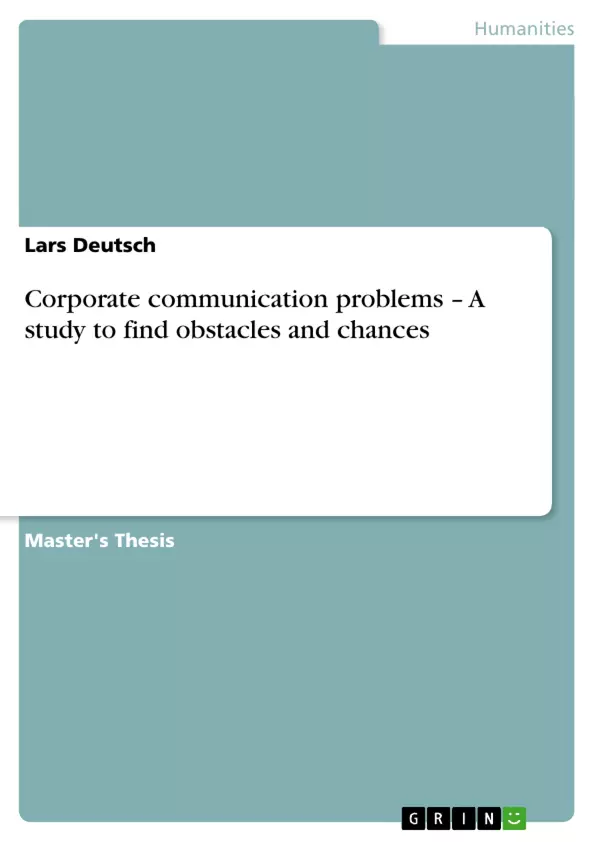This study has been motivated by the author’s perception of the problems experienced in his professional career in the IT industry. Although project participants are not lacking in skill or expertise, often IT projects seem not to have the expected outcome. Communication obstacles prevent a full understanding of each others problems. The real issues to be solved are filtered by hierarchical levels, differences in education and different meanings of specific topics.
Even if technical and non-technical project participants think they understand each other, in reality they don’t. This results in unnecessary work for all persons involved and higher project costs. This text tries to find the reasons for these communication obstacles and underlying root causes. Based on these findings recommendations and fields of further research are being developed.
Inhaltsverzeichnis (Table of Contents)
- Introduction
- Objectives and Observations
- Research Background
- Scope and Structure
- Focus and Limitations
- Existing approaches to improve communication and cooperation
- Interdisciplinary education approaches
- Agile Software Development
- The learning organization
- Thesis from existing approaches
- Theories on the causes of communication problems
- Communication theory
- Models of conflicts in communication
- Personality and Values in communication
- Motives
- McClelland Achievement-Power-Affiliation theory
- Muslow's Hierarchy of Needs
- Summary of motivation theories
- Motivation priorities of professionals
- Competence at work
- Definition of competencies
- Competencies of non technical staff
- Competencies of technical staff
- Key differences in competencies between technical and non-technical staff
- Key findings of previous research
- Study on finding communication obstacles and chances
- Tentative Hypotheses
- Block A Interviewee Background
- Block B Competencies
- Block C Motivation
- Block D opinions on corporate communication and cooperation
Zielsetzung und Themenschwerpunkte (Objectives and Key Themes)
This Master's Thesis explores the communication problems encountered in the IT industry, aiming to identify obstacles and opportunities for improvement. The research focuses on understanding the factors that contribute to these issues and proposes solutions for enhancing communication and cooperation within IT projects.
- Communication challenges in IT projects
- The impact of different motivations and competencies on communication effectiveness
- Exploring theories and models related to communication, conflict, and motivation
- Analyzing the role of competencies in technical and non-technical staff in IT projects
- Identifying potential solutions and strategies to improve communication and cooperation
Zusammenfassung der Kapitel (Chapter Summaries)
- Introduction: This chapter outlines the author's motivation for conducting the study, highlighting the prevalence of communication problems in IT projects. The chapter cites existing research findings and real-world observations to emphasize the need for addressing these issues.
- Existing approaches to improve communication and cooperation: This chapter explores existing approaches and theories aimed at improving communication and collaboration, focusing on interdisciplinary education, agile software development, and the learning organization concept. The chapter analyzes these approaches and identifies potential benefits and limitations in the context of IT project management.
- Theories on the causes of communication problems: This chapter dives deeper into communication theory, exploring models of conflict in communication and analyzing the role of personality, values, and motivations in influencing communication dynamics. The chapter examines key theories like McClelland's Achievement-Power-Affiliation theory and Maslow's Hierarchy of Needs, providing a framework for understanding the motivations of individuals involved in IT projects.
- Competence at work: This chapter delves into the concept of competence in the workplace, examining the definition of competencies and their role in communication and project success. The chapter analyzes the specific competencies required by technical and non-technical staff in IT projects, highlighting key differences in skills and knowledge needed for effective communication and collaboration.
- Key findings of previous research: This chapter summarizes relevant research findings from previous studies on communication problems in IT projects. The chapter presents insights into the nature and prevalence of these issues, drawing from various sources to provide a comprehensive overview of existing knowledge in the field.
- Study on finding communication obstacles and chances: This chapter presents the author's own research methodology, outlining the tentative hypotheses and the structure of the study. The chapter provides details about the interviewee background, the focus on competencies, motivation, and opinions on corporate communication and cooperation.
Schlüsselwörter (Keywords)
The primary keywords and focus topics of this study include IT project communication, corporate communication, communication problems, competencies, motivation, communication theory, conflict management, interdisciplinary education, agile software development, and the learning organization. The research explores these topics within the context of IT project management and seeks to identify strategies for overcoming communication challenges and enhancing cooperation within IT teams.
- Quote paper
- Dipl.Inform.(FH), MBA Lars Deutsch (Author), 2005, Corporate communication problems – A study to find obstacles and chances, Munich, GRIN Verlag, https://www.grin.com/document/85574



